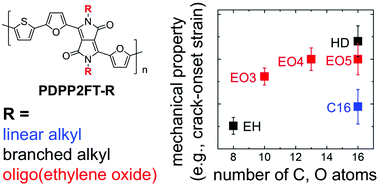Effects of flexibility and branching of side chains on the mechanical properties of low-bandgap conjugated polymers†
Abstract
This paper describes effects of the flexibility, length, and branching of side chains on the mechanical properties of low-bandgap semiconducting polymers. The backbones of the polymer chains comprise a diketopyrrolopyrrole (DPP) motif flanked by two furan rings and copolymerized by Stille polycondensation with thiophene (DPP2FT). The side chains of the DPP fall into three categories: linear alkyl (C8, C14, or C16), branched alkyl (ethylhexyl, EH, or hexyldecyl, HD), and linear oligo(ethylene oxide) (EO3, EO4, or EO5). Polymers bearing C8 and C14 side chains are obtained in low yields and thus not pursued. Thermal, mechanical, and electronic properties are plotted against the number of carbon and oxygen atoms in the side chain. We obtain consistent trends in the thermal and mechanical properties for branched alkyl and linear oligo(ethylene oxide) side chains. For example, the glass transition temperature (Tg) and elastic modulus decrease with increasing number of carbon and oxygen atoms, whereas the crack-onset strain increases. Among polymers with side chains of 16 carbon and oxygen atoms (C16, HD, and EO5), C16 exhibits the highest Tg and the greatest susceptibility to fracture. Hole mobility, as measured in thin-film transistors, appears to be a poor predictor of electronic performance for polymers blended with [60]PCBM in bulk heterojunction (BHJ) solar cells. For example, while EO3 and EO4 exhibit the lowest mobilities (<10−2 cm2 V−1 s−1) in thin-film transistors, solar cells made using these materials performed the best (efficiency > 2.6%) in unoptimized devices. Conversely, C16 exhibits the highest mobility (≈0.2 cm2 V−1 s−1) but produces poor solar cells (efficiency < 0.01%). We attribute the lack of correlation between mobility and power conversion efficiency to unfavorable morphology in the BHJ solar cells. Given the desirable properties measured for EO3 and EO4, the use of flexible oligo(ethylene oxide) side chains is a successful strategy to impart mechanical deformability to organic solar cells without sacrificing electronic performance.

- This article is part of the themed collection: Polymer Chemistry 15th anniversary regional spotlight collection: The Americas


 Please wait while we load your content...
Please wait while we load your content...